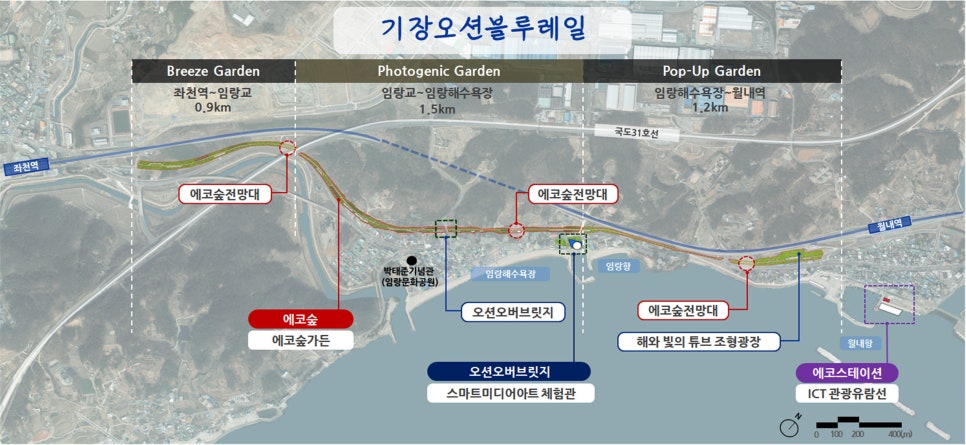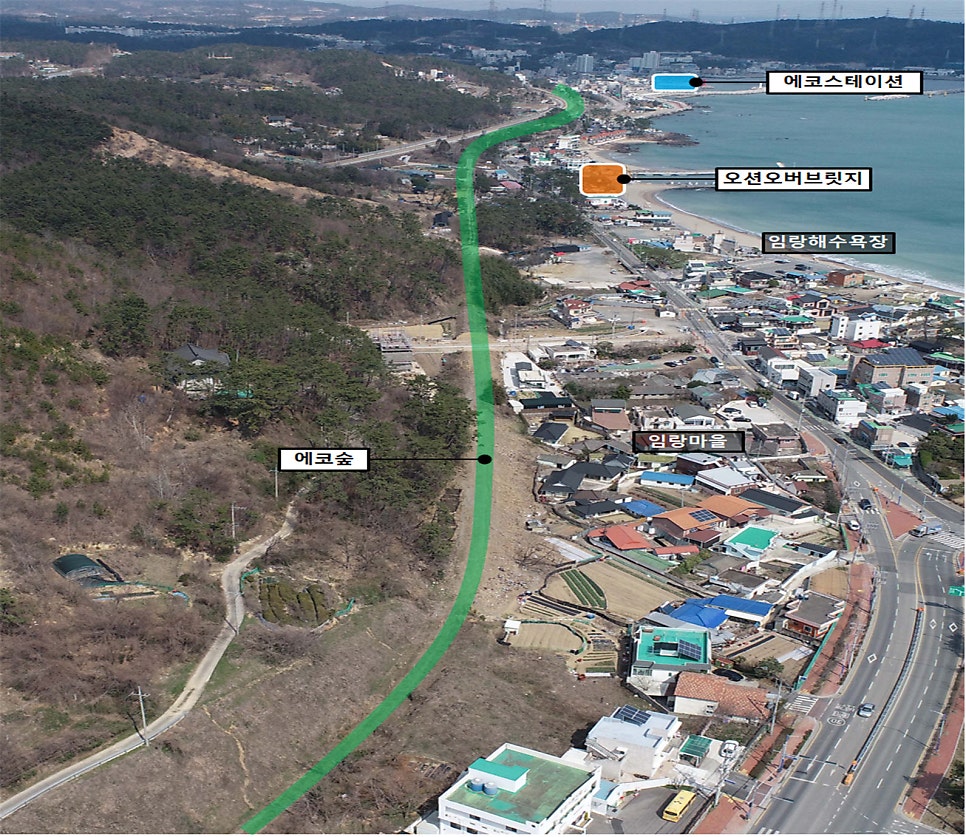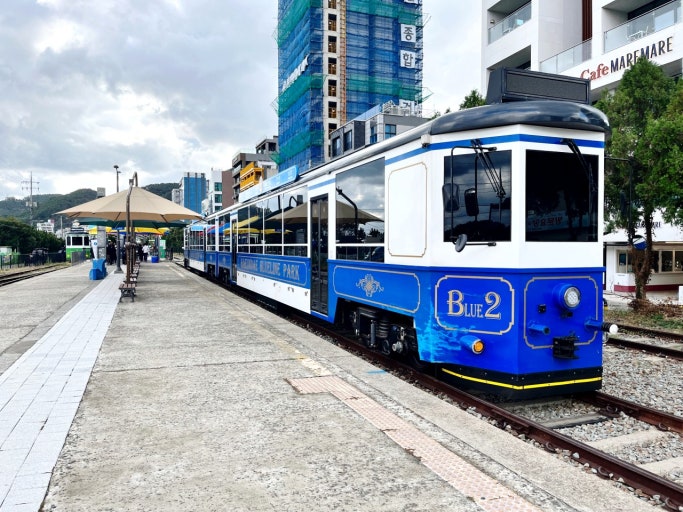Table of Contents
- The abandoned East Coast South Line railway site is reborn as tourism infrastructure
- Creating a marine tourism belt where nature and technology coexist
- Start of full-scale design from 2025… Aiming to open in 2029
- First step toward becoming a tourism city, Gijang… Projects like K-Culture Town are also in progress
- Conclusion: Gijang Ocean Blue Rail, a turning point for leapfrogging into a marine tourism mecca
- Frequently Asked Questions (FAQ)
The abandoned East Coast South Line railway site is reborn as tourism infrastructure

The 'Gijang Ocean Blue Rail construction project', which will change the tourism terrain of Gijang-gun, is officially underway after receiving approval from the Central Investment Review of the Ministry of the Interior and Safety.
This project is led by Gijang-gun, and aims to promote the development of regional tourism in the southern area through support from the Ministry of Culture, Sports and Tourism.
The project plans to utilize the abandoned railway site (3.6 km long, 15 m wide) connecting Jwa-cheon Station and Wolnae Station in Gijang-gun to establish ecological, cultural, and ICT-related tourism facilities.
Creating a marine tourism belt where nature and technology coexist

This project aims to create a complex tourist destination that provides unique tourism experiences in the Gijang area, going beyond simple utilization of the abandoned railway.
The main facilities include Eco Forest, an eco-friendly ecological relaxation space, Ocean Over Bridge, which allows visitors to enjoy the sea in front of Gijang, Eco Station, a cruise terminal utilizing ICT technology, and a media art experience center.
In particular, tourist programs combined with marine leisure are also planned around Wolnae Port, which is expected to increase tourists' length of stay and consumption.
Start of full-scale design from 2025… Aiming to open in 2029

The total project cost is estimated at 39.16 billion won, which will be shared by 50% national funds, 25% city funds, and 25% county funds.
As the eligibility review by the Ministry of Culture, Sports and Tourism, the pre-feasibility study by the Ministry of Strategy and Finance, and the Central Investment Review will be completed by 2024, the project is set to move into the detailed design phase and begin construction in 2027. Completion is scheduled for 2028, with the aim of opening in 2029.
In this regard, Gijang-gun stated, “We will do our best to secure project funding and proceed swiftly with subsequent procedures including basic and detailed design and consultation with relevant agencies,” promising that the project will proceed smoothly.
First step toward becoming a tourism city, Gijang… Projects like K-Culture Town are also in progress

The Gijang Ocean Blue Rail project is a key promise made by the members of the National Assembly and the county mayor of Gijang-gun, establishing itself as a core tourism strategy. Alongside this, projects linking surrounding tourist sites such as the establishment of K-Culture Town utilizing the ceramics village site and the development of the Jeonggwan themed tourist site are also underway. These plans represent a blueprint for developing Gijang into a ‘global marine tourism hub’ and are gradually being concretized.
This project is expected to have a positive impact on the tourism industry. According to an analysis by the Ministry of Culture, Sports and Tourism, the Gijang Ocean Blue Rail project is anticipated to generate 66.2 billion won in production effects and 6 billion won in revenue effects. In addition, it is expected to create a value-added effect of 26.7 billion won, which will contribute to the revitalization of the local economy and job creation.
Conclusion: Gijang Ocean Blue Rail, a turning point for leapfrogging into a marine tourism mecca

The Gijang Ocean Blue Rail project is a meaningful venture that goes beyond simply creating tourism infrastructure, achieving both urban regeneration and the fusion of tourism and culture at the same time. In particular, it creatively utilizes the abandoned railway site while preserving the local characteristics, similar to the Haeundae Blue Line Park, and is notable for establishing facilities that align with future tourism trends.
The focus now is on whether this project can help Gijang develop into the tourism center of the eastern part of Busan. The target opening year is 2029, and it is crucial that the administrative procedures and processes proceed smoothly. We hope that the abandoned railway site of the East Coast South Line transforms into the best eco-friendly marine culture tourism site in the southern region.
#GijangOceanBlueRail, #GijangTourism, #GijangCounty, #Jwa-cheonStation, #WolnaeStation, #abandonedEastCoastSouthLine, #BusanTourism, #SouthernRegionalTourismDevelopment, #BusanMarineTourism, #EcoStation, #OceanOverBridge, #EcoForest, #GijangRailTour, #openingIn2029, #GijangHotPlace, #cruiseTour, #newTouristAttractionInBusan, #GijangCountyOffice, #MinistryOfCultureSportsAndTourism, #passedMinistryOfStrategyAndFinanceReview, #passedCentralInvestmentReview, #utilizationOfAbandonedRail, #tourismRail, #BusanKCultureTown, #GijangCeramicsVillage, #GijangMediaArt, #recommendedTravelInBusan, #GijangWolnaePort, #BusanGijangHotPlace, #MarineTourismBelt
Frequently Asked Questions (FAQ)
Q. What is the Gijang Ocean Blue Rail project?
The Gijang Ocean Blue Rail is a tourism infrastructure project that creates an eco-friendly marine tourism belt using the abandoned East Coast South Line.
The Gijang Ocean Blue Rail construction project is a large-scale project that installs ecological, cultural, and ICT tourism facilities on the 3.6 km abandoned railway site from Jwa-cheon Station in Busan Gijang-gun to Wolnae Station. It is led by Gijang-gun and aims to develop southern regional tourism systems with the support of the Ministry of Culture, Sports and Tourism. This project includes various facilities such as Eco Forest, Ocean Over Bridge, Eco Station, and a media art experience center to create a unique complex tourist destination.
Q. What are the main tourism facilities of the Gijang Ocean Blue Rail project?
Various tourism facilities will be created including Eco Forest, Ocean Over Bridge, Eco Station, and media art experience center.
Main facilities include Eco Forest, an eco-friendly ecological relaxation space, and Ocean Over Bridge, which allows visitors to enjoy the sea in front of Gijang. Additionally, Eco Station, which serves as a cruise terminal incorporating ICT technology, and a space for visitors to experience media art are also included. Various tourism programs linked to marine leisure are also planned near Wolnae Port, which is expected to contribute to increasing tourists' stays and spending.
Q. What is the timeline and budget for the project?
Project cost is 39.1 billion won, expected to start construction in 2027, complete in 2028, and open in 2029.
The total project cost is 39.16 billion won, of which 50% will be national funding, 25% city funding, and 25% county funding. The central investment review was completed in 2023 and related review processes will be completed by 2024, after which detailed design services will be implemented. Construction is expected to start in 2027 with a target completion in 2028 and opening in 2029. Gijang-gun stated that they plan to expedite securing project funding and consulting with relevant agencies.
Q. What are the economic effects of the Gijang Ocean Blue Rail on the region?
Expected to generate 66.2 billion won in production effects, 26.7 billion won in value-added, and create jobs, thereby revitalizing the local economy.
According to the analysis by the Ministry of Culture, Sports and Tourism, the project is expected to generate production effects of 66.2 billion won and revenue effects of 6 billion won. In addition, a value-added effect of 26.7 billion won is anticipated, which is evaluated as a positive influence on revitalizing the local economy and creating numerous jobs. Thus, it is expected to be a robust growth driver across the local economy, beyond just developing tourism infrastructure.
Q. What other tourism development plans are linked to the Gijang Ocean Blue Rail project?
Projects are underway to create K-Culture Town and develop themed tourist sites in Jeonggwan, linking to surrounding tourist sites.
Alongside the Gijang Ocean Blue Rail, there are plans to create K-Culture Town utilizing the ceramics village site and develop themed tourist sites in Jeonggwan. These projects are part of a strategic plan to cultivate Gijang as a global marine tourism hub, and they aim to multilaterally expand local tourism infrastructure and promote tourist influx. This is expected to lead to sustainable regional tourism development where tourism and culture converge.